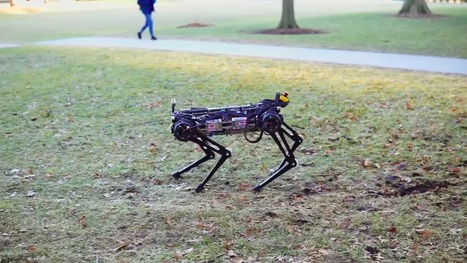In a turn away from vision, a team at MIT has created a feline robot that attempts to better approximate how humans and animals actually move, navigating stairs and uneven surfaces guided only by sensors on its feet.
Why it matters: Many ambulatory robots rely on substantial recent improvements in computer-vision, like advanced cameras and lidar. But robots will be more nimble and more practically interact with humans with the addition of "blind" vision — a sixth sense of feeling that most living things have for their surroundings.
What's going on: Computer vision alone can result in a robot with slow and inaccurate movements, says MIT's Songbae Kim, designer of the Cheetah 3.
- "People start adding vision prematurely and they rely on it too much," Kim tells Axios, when it's best suited for big-picture planning, like registering where a stairway begins and knowing when to turn to avoid a wall. So his team built a "blind" version in order to focus on tactile sensing.
How the blind version works: Two algorithms help the Cheetah stay upright when it encounters unexpected obstacles.
- One determines when the bot plants its feet, by calculating how far a leg has swung, how much force the leg is feeling, and where the ground is.
- The other governs how much force the robot should apply to each leg to keep its balance, based on the angle of the robot's body relative to the ground.
- The sensors can also adjust to external forces, like a researcher's friendly kick from the side.
The result is a quick, balanced robot: The researchers measure the force on each of the Cheetah's legs straight from the motors that control them, allowing it to move fast — at 3 meters per second, or 6.7 miles an hour — and jump up onto a tablefrom a standstill. These tricks make the 90-pound bot look surprisingly nimble.
Cheetah's design emphasizes "sensors that you and I take for granted," said Noah Cowan, director of the LIMBS robotics lab at Johns Hopkins University.
- Humans unconsciously keep track of where their arms and legs are — and the forces acting on them — to help stay balanced and move smoothly. MIT’s Cheetah “feels” its legs in a similar way.
The Cheetah's capabilities resemble some of the robots produced by the ever-secretive Boston Dynamics, which in May released a video of its four-legged SpotMini navigating autonomously through its lab with the help of cameras.
- It's not clear whether Boston Dynamic robots use tactile technology like Kim's, and the company did not respond to an email.



 Your new post is loading...
Your new post is loading...








It "looks" like machine vision is not necessarily mandatory when it comes to designing efficient "walking" machines.